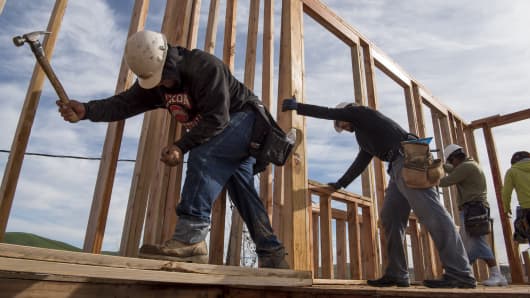Inflation is slowly warming and the job numbers continue to improve. The Federal Reserve, therefore, is seeking to boost interest rates to contain inflation down the road.
Two swift rate hikes in a span of four months, one in December 2016 and then again in March 2017, could just be the beginning of multiple rate hikes over the next several years. Many economists (and me included) perceive a fully normalized federal-funds rate (the rate banks charge each other for overnight loans) to be at 3 percent to 3.5 percent, which would then call for an additional 8 to 10 rounds of quarter point raises.
There is a way to slow the pace of interest-rate increases: Build more homes.
A deep dive into the latest inflation figures shows that housing components are rising much faster than most other components. Specifically, rent rose 3.9 percent, while the homeowners' equivalent of rent increased by 3.5 percent. The latter requires assumptions and is a bit fuzzy, but essentially, it tries to measure what homeowners would pay in rent to live in the home they own. Still, market forces and home price movements would imply that the owner equivalent of rent should be something resembling what renters are paying. With rent rising faster than the homeowner equivalent, and home prices rising at an even faster pace (6 percent to 7 percent gains depending upon what source you're looking at), it is probable that the homeowner's component will rise further in upcoming months.
Moreover, housing components carry a large weight in the total consumer price index and hence are prime movers of overall inflation figures. Bread, for example, takes up only 0.2 percent of most people's budget and is therefore given a corresponding weight. Rent carries 7.8 percent weight while the homeowners' equivalent of rent takes up a massive 24.5 percent.
Over the past two years, the huge collapse in gasoline prices has had largely neutered inflationary pressures, but if further price collapses in energy prices are not forthcoming — that is, if one does not believe gasoline prices will reach $1 per gallon at the pump — then it is inevitable that housing costs will dictate overall inflation and interest-rate policy in the near future.
How, then, to contain housing costs and slow down inflation? Build more apartments and single-family homes. Historically, the country adds 1.5 million new housing units each year. The economic logic is straightforward, with around 1 to 1.2 million new households formed in the country combined with around 300,000 to 400,000 demolished or newly uninhabitable homes each year, about 1.5 million new units are required. Some down years were quickly compensated with robust building in subsequent years to get to the average of 1.5 million.
Not this time. There was indeed an overbuilding during the boom-bubble years, averaging 1.9 million housing starts from 2003 to 2006. However, the downturn has been deep and very long. Over the past 10 years from 2007 to 2016, average housing starts were 900,000 per year. That is grossly inadequate. That is why there is a housing shortage across the country. Inventory supply of homes available for sale remains at historic lows, and rental vacancy rates have fallen to under 7 percent, the lowest since the mid-1980s.
The faster the homebuilding recovery, the slower the housing inflation. Consequently, the broader consumer price index will also slow and thereby allow more breathing room for the Fed to temper the pace of rate hikes.
Commentary by Lawrence Yun, the chief economist and senior vice president of research at the National Association of Realtors. Follow the NAR on Twitter @NAR_Research.
Follow CNBC's Opinion section on Twitter @CNBCopinion.


